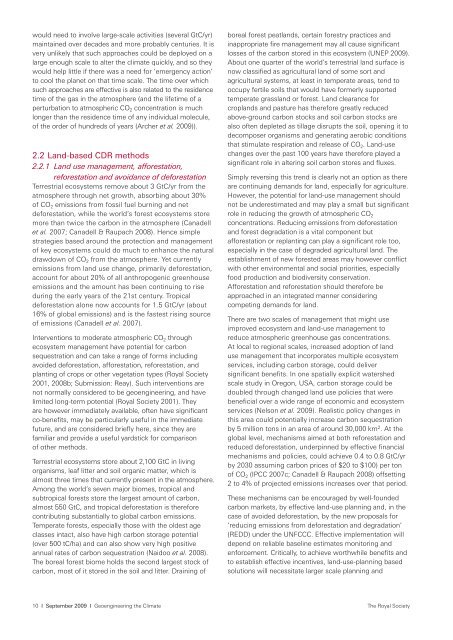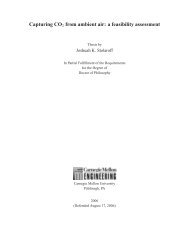Royal Society - David Keith
Royal Society - David Keith
Royal Society - David Keith
You also want an ePaper? Increase the reach of your titles
YUMPU automatically turns print PDFs into web optimized ePapers that Google loves.
would need to involve large-scale activities (several GtC/yr)<br />
maintained over decades and more probably centuries. It is<br />
very unlikely that such approaches could be deployed on a<br />
large enough scale to alter the climate quickly, and so they<br />
would help little if there was a need for ‘emergency action’<br />
to cool the planet on that time scale. The time over which<br />
such approaches are effective is also related to the residence<br />
time of the gas in the atmosphere (and the lifetime of a<br />
perturbation to atmospheric CO 2 concentration is much<br />
longer than the residence time of any individual molecule,<br />
of the order of hundreds of years (Archer et al. 2009)).<br />
2.2 Land-based CDR methods<br />
2.2.1 Land use management, afforestation,<br />
reforestation and avoidance of deforestation<br />
Terrestrial ecosystems remove about 3 GtC/yr from the<br />
atmosphere through net growth, absorbing about 30%<br />
of CO 2 emissions from fossil fuel burning and net<br />
deforestation, while the world’s forest ecosystems store<br />
more than twice the carbon in the atmosphere (Canadell<br />
et al. 2007; Canadell & Raupach 2008). Hence simple<br />
strategies based around the protection and management<br />
of key ecosystems could do much to enhance the natural<br />
drawdown of CO 2 from the atmosphere. Yet currently<br />
emissions from land use change, primarily deforestation,<br />
account for about 20% of all anthropogenic greenhouse<br />
emissions and the amount has been continuing to rise<br />
during the early years of the 21st century. Tropical<br />
deforestation alone now accounts for 1.5 GtC/yr (about<br />
16% of global emissions) and is the fastest rising source<br />
of emissions (Canadell et al. 2007).<br />
Interventions to moderate atmospheric CO 2 through<br />
ecosystem management have potential for carbon<br />
sequestration and can take a range of forms including<br />
avoided deforestation, afforestation, reforestation, and<br />
planting of crops or other vegetation types (<strong>Royal</strong> <strong>Society</strong><br />
2001, 2008b; Submission: Reay). Such interventions are<br />
not normally considered to be geoengineering, and have<br />
limited long-term potential (<strong>Royal</strong> <strong>Society</strong> 2001). They<br />
are however immediately available, often have significant<br />
co-benefits, may be particularly useful in the immediate<br />
future, and are considered briefly here, since they are<br />
familiar and provide a useful yardstick for comparison<br />
of other methods.<br />
Terrestrial ecosystems store about 2,100 GtC in living<br />
organisms, leaf litter and soil organic matter, which is<br />
almost three times that currently present in the atmosphere.<br />
Among the world’s seven major biomes, tropical and<br />
subtropical forests store the largest amount of carbon,<br />
almost 550 GtC, and tropical deforestation is therefore<br />
contributing substantially to global carbon emissions.<br />
Temperate forests, especially those with the oldest age<br />
classes intact, also have high carbon storage potential<br />
(over 500 tC/ha) and can also show very high positive<br />
annual rates of carbon sequestration (Naidoo et al. 2008).<br />
The boreal forest biome holds the second largest stock of<br />
carbon, most of it stored in the soil and litter. Draining of<br />
boreal forest peatlands, certain forestry practices and<br />
inappropriate fire management may all cause significant<br />
losses of the carbon stored in this ecosystem (UNEP 2009).<br />
About one quarter of the world’s terrestrial land surface is<br />
now classified as agricultural land of some sort and<br />
agricultural systems, at least in temperate areas, tend to<br />
occupy fertile soils that would have formerly supported<br />
temperate grassland or forest. Land clearance for<br />
croplands and pasture has therefore greatly reduced<br />
above-ground carbon stocks and soil carbon stocks are<br />
also often depleted as tillage disrupts the soil, opening it to<br />
decomposer organisms and generating aerobic conditions<br />
that stimulate respiration and release of CO 2 . Land-use<br />
changes over the past 100 years have therefore played a<br />
significant role in altering soil carbon stores and fluxes.<br />
Simply reversing this trend is clearly not an option as there<br />
are continuing demands for land, especially for agriculture.<br />
However, the potential for land-use management should<br />
not be underestimated and may play a small but significant<br />
role in reducing the growth of atmospheric CO 2<br />
concentrations. Reducing emissions from deforestation<br />
and forest degradation is a vital component but<br />
afforestation or replanting can play a significant role too,<br />
especially in the case of degraded agricultural land. The<br />
establishment of new forested areas may however conflict<br />
with other environmental and social priorities, especially<br />
food production and biodiversity conservation.<br />
Afforestation and reforestation should therefore be<br />
approached in an integrated manner considering<br />
competing demands for land.<br />
There are two scales of management that might use<br />
improved ecosystem and land-use management to<br />
reduce atmospheric greenhouse gas concentrations.<br />
At local to regional scales, increased adoption of land<br />
use management that incorporates multiple ecosystem<br />
services, including carbon storage, could deliver<br />
significant benefits. In one spatially explicit watershed<br />
scale study in Oregon, USA, carbon storage could be<br />
doubled through changed land use policies that were<br />
beneficial over a wide range of economic and ecosystem<br />
services (Nelson et al. 2009). Realistic policy changes in<br />
this area could potentially increase carbon sequestration<br />
by 5 million tons in an area of around 30,000 km 2 . At the<br />
global level, mechanisms aimed at both reforestation and<br />
reduced deforestation, underpinned by effective financial<br />
mechanisms and policies, could achieve 0.4 to 0.8 GtC/yr<br />
by 2030 assuming carbon prices of $20 to $100) per ton<br />
of CO 2 (IPCC 2007c; Canadell & Raupach 2008) offsetting<br />
2 to 4% of projected emissions increases over that period.<br />
These mechanisms can be encouraged by well-founded<br />
carbon markets, by effective land-use planning and, in the<br />
case of avoided deforestation, by the new proposals for<br />
‘reducing emissions from deforestation and degradation’<br />
(REDD) under the UNFCCC. Effective implementation will<br />
depend on reliable baseline estimates monitoring and<br />
enforcement. Critically, to achieve worthwhile benefits and<br />
to establish effective incentives, land-use-planning based<br />
solutions will necessitate larger scale planning and<br />
10 I September 2009 I Geoengineering the Climate The <strong>Royal</strong> <strong>Society</strong>








